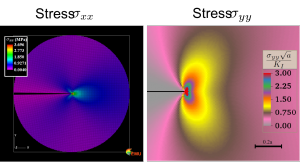PARTICIPANTS: M SCOT BREITENFELD, OLAF WECKNER (BOEING, SEATTLE WA), STEWART SILLING (SANDIA NATIONAL LAB, ALBUQUEQUE, NM)
SUPPORT: BOEING, SEATTLE WA
PROJECT DESCRIPTION: A majority of the efforts to date in modeling fracture have used continuum models built upon using partial derivatives with respect to the spatial coordinates in the force and displacement relationship between adjacent particles. However, these methods are inherently ill-suited for modeling cracks because the partial derivatives are undefined along the crack where the displacement field is discontinuous. Consequently, in order for these methods to model fracture, they have to remove the discontinuous displacement field either by redefining the body, using various methods, such that the crack lies on the boundary or by using other method-specific techniques for evaluating the spatial derivatives on crack surfaces.
In contrast, peridynamics is a continuum model for efficiently handling the spontaneous formation, propagation, branching and coalescing of cracks by using integration rather than differentiation to compute the force at a material point, resulting in valid equations everywhere in the body. Consequently, particles are influenced by other particles, via bonds, separated over a finite distance; hence the method is classified as a nonlocal theory.
Efforts to date using the non-ordinary state-based formulation are very few and have focused exclusively on the explicit formulation for dynamic simulations. Our research focuses on extending the non-ordinary state-based peridynamics formulation to quasi-static fracture using an implicit method. One asset of the non-ordinary state-based formulation is the fact that the bond force between particles is characterized in terms of strain and stress tensors and, therefore, allows for classical continuum mechanics definitions such as deformation gradients and stress tensors for use in constitutive models. The new implicit quasi-static linear elastic small strain formulation has been implemented in the peridynamics code Emu from Sandia National Laboratories. Figure # shows an example of spontaneous crack growth using non-ordinary state-based peridynamics for a double cantilever beam with a weakened mid-plane under displacement control loading. The stress concentration at the crack tip is clearly captured as the crack propagates.

Peridynamics analysis of crack propagation in a Double Cantilever Beam (DCB) specimen.

Near-tip stress fields predicted by the peridynamics method.
PUBLICATIONS:
- Breitenfeld, S. M., Geubelle, P. H., Weckner, O., and Silling, S. A. (2016) “Relations Between Peridynamics and Classical Cohesive Models.” In Handbook of Peridynamic Modeling. Edited by Florin Bobaru, John Foster, Philippe Geubelle and Stewart Silling. Chapter 11, pp. 321-340.
- Breitenfeld, M. S., Geubelle, P. H., Weckner, O., and Silling, S. A. (2013) “Non-ordinary state-based peridynamic analysis of stationary crack problems.” Computer Methods in Applied Mechanics and Engineering, 272, 233-250.